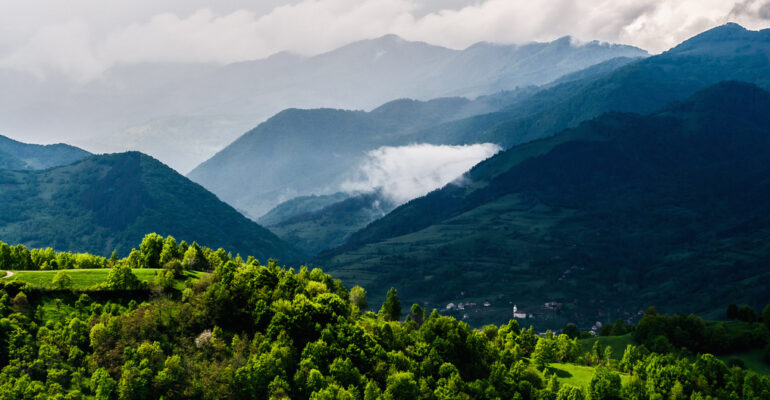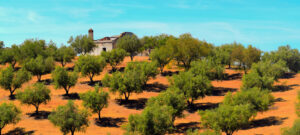Romania – Up in Flames
By guest author Fred Pearce, author and journalist – article from Fern’s report ‘Up in Flames’
Romania’s forests are being over-exploited to supply demand for biomass both within the country and across Europe. While the logging business remains dominated by the state company Romsilva, its markets are increasingly international, with Austrian companies in particular driving an orgy of forest destruction. Three-quarters of the 300,000 tonnes of wood pellets manufactured annually in Romania are exported.1 And there is growing concern that a combination of government subsidies and foreign markets is feeding the growth of a timber mafia in the country. Biomass burning has become a cause of corruption and conflict in Romania.
Around 20 million cubic metres of wood are harvested1 annually in Romania, mostly in mountain regions such as the Carpathians. Greenpeace estimates that more than 250,000 hectares of forest has been lost or severely degraded since timber markets were liberalised 12 years ago, with old-growth forests widely targeted. At least a quarter of the harvest, five million cubic metres, is burned as biomass fuel within the country. This figure is expected to rise to 7.5 million cubic metres by 2020, as the government attempts to achieve its aim of obtaining a quarter of its energy from renewables.2
But exports are a growing part of the market and foreign companies now dominate the industry. The largest Austrian company, Holzindustrie Schweighofer, which processes an estimate 40 per cent of the country’s softwood production for biomass pellets and other uses, has been honoured as “investor of the year” in Romania. Owned by the Schweighofers, one of Austria’s richest families, it claims to process some 2.4 million cubic metres of Romanian timber annually.3 An estimated 60 per cent of its exports go for biomass burning in power plants in Austria and Germany.
Other foreign companies have recently begun buying forests directly. The Luxembourg-based Forest Value InvestmentManagement, says it bought the “exceptionally dense” 4,000- hectare beech stands of the Petris forest in 2013 to supply “potential biomass energy users”.4 There is a strong stench of corruption in the Romanian forestry industry that some analysts say has been triggered by the arrival of foreign companies and the subsidies that encourage them. Early in 2015, the state corruption agency began investigations into Romsilva officials, including its director, Adam Craciunescu.5
“We have established a clear link between illegal logging in Romania and the EU wood pellet market,” says Susanne Breitkopf of the Environmental Investigation Agency in Washington DC, which has tracked timber from the forests of Romania’s Carpathian Mountains to its chipping and pellet mills and on to power stations boilers in Austria and Germany. EIA charges Schweighofer with processing “large amounts of illegal wood” and being “the single biggest driver of illegal logging in the country over the past decade”. Its named customers include Austrian biomass companies Genol and Drauholz.6
In 2012, Greenpeace reported widespread illegal logging, with dozens of cases reported to the authorities every day.7 A local NGO, Agent Green, has estimated that 366,000 hectares of Romanian forest has been illegally felled since 1990.
The RISE project, a group of journalists investigating corruption in Romania, has in the past year questioned the legality of Schweighofer’s supplies.8 It uncovered reports by inspectors at the country’s Ministry of Environment that timber at the company’s mills did not always have proper documentation, and often exceeded the volumes claimed. One report into the Sebes mill in Transylvania found that “the entries of timber and the final stocks have been distorted, generating a fictitious origin.”9
The EIA published a video showing Schweighofer employees apparently agreeing to buy illegal timber from investigators posing as foreign investors.10 The company has denied being complicit in any illegality.11 The company says it “makes all possible efforts… to help end the illegal logging phenomenon”, including reporting suspect deliveries and terminating contracts with companies that do not meet its standards. “We accept only deliveries that have all the data required by the law.” It says the statements in the EIA video “were taken out of context”.12
Meanwhile, local timber companies, including furniture makers, have gone bankrupt and blamed the emergence of foreign firms for their demise. They say the companies use government subsidies for green energy to out-compete them for high-value wood.
Public anger over the state of Romania’s forests is growing. There were major protests in spring 2015 against illegal deforestation, logging in national parks and the activities of Austrian timber companies in particular. The government has responded by introducing a new forest code. But Schweighofer has found itself pilloried for lobbying publicly against provisions in the code that would limit one company to a market share of 30%.13
1 Borz et al. (2013). Report ‘Regional Profile of the Biomass Sector in Romania’. FOROPA Biomass to the Masses http://www.foropa.eu/files/country_reports/country%20report%20romania.pdf
2 Borz et al. (2013). http://www.foropa.eu/files/country_reports/country%20report%20romania.pdf
3 Holzindustrie Schweighofer (2014). Press release ‘Holzindustrie Schweighofer – Austrian investor of the year in Romania’. https://www.schweighofer.at/fileadmin/files/all_en/Press/Holzindustrie_Schweighofer_Investor_of_the_year_in_Romania.pdf
4 Forest Value Investment Management S.A. (2011) Press release ‘Forest and biomass acquires the Petris forest in Romania – first step in production of sustainable biomass’. www.beetlecapitalpartners.com/index.php/download_file/25/122
5 BBC News (2015). Online article ‘Romania acts to save forests from logging spree’. http://www.bbc.co.uk/news/world-europe-32792314
6 Environmental Investigation Agency (2015). Report ‘ Stealing the last forest: Austria’s largest timber company, land rights, and corruption in Romania’. http://eia-global.org/campaigns/forests-campaign/stealing-the-last-forest/
7 Greenpeace (2012). Online article ‘Illegal logging cases in Romanian forests’. http://www.greenpeace.org/romania/Global/romania/paduri/Publicatii/Illegal%20logging%20reports%20Romania%202012_AR.pdf
8 RISE Project (2015). Online article ‘Schweighofer at the center of the illegal deforestationscandal in Romania’. http://www.risproject.ro
9 RISE Project (2015). Online article ‘Control la Schweighofer: trafic de lemn și fraude cucertificate verzi’ (Romanian) http://www.riseproject.ro/control-la-schweighofer-trafic-delemn-si-fraude-cu-certificate-verzi/
10 Environmental Investigation Agency (2015). Online article ‘Austrian company exposed offering bonuses for illegal Romanian timber’. http://eia-global.org/news-media/austriancompany-exposed
11 Global Timber Forum (2015). Online article ‘Schweighofer rejects all accusations regarding use of illegal timber’. http://gtf-info.com/news/market-legality-requirements/1939-schweighofer-rejects-all-accusations-regarding-use-of-illegal-timber
12 https://www.schweighofer.at/fileadmin/files/all_en/Press/Statement_-_HS_clarifications_towards_EIA_report_EN.pdf; https://www.schweighofer.at/fileadmin/files/all_en/Press/HS_statement_-_EIA_report_Oct_21_EN.pdf
13 Holzindustrie Schweighofer (2015). Letter to Romanian Government, available at Schweighofer’s homepage. https://www.schweighofer.at/fileadmin/files/all/startseite/doc00461720150512160743.pdf
Photo credit: Romanian forest (c) Sergiu Bacioiu, Flickr Creative Commons
Note: The views and opinions expressed in this guest blog post are those of the author and are not necessarily supported by BirdLife Europe/EEB/T&E.





